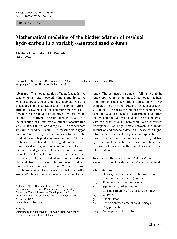摘要
The biodegradation of heptadecane in five sand columns was modeled using a multiplicative Monod approach. Each column contained 1.0 kg of sand and 2 g of heptadecane, and was supplied with an artificial seawater solution containing nutrients at a flow rate that resulted in unsaturated flow through the column. All nutrients were provided in excess with the exception of nitrate whose influent concentration was 0.1, 0.5, 1.0, 2.5, or 5.0 mg N/L. The experiment was run around 912 h until no measurable oxygen consumption or CO2 production was observed. The residual mass of heptadecane was measured at the end of the experiments and the biodegradation was monitored based on oxygen consumption and CO2 production. Biodegradation kinetic parameters were estimated by fitting the model to experimental data of oxygen, CO2, and residual mass of heptadecane obtained from the two columns having influent nitrate-N concentration of 0.5 and 2.5 mg/L. Noting that the oxygen and CO2 measurements leveled off at around 450 h, we fitted the model to these data for that range. The estimated parameters fell in within the range reported in the literature. In particular, the half-saturation constant for nitrate utilization, , was estimated to be 0.45 mg N/L, and the yield coefficient was found to be 0.15 mg biomass/mg heptadecane. Using these values, the rest of experimental data from the five columns was predicted, and the model agreed with the observations. There were some consistent discrepancies at large times between the model simulation and observed data in the cases with higher nitrate concentration. One plausible explanation for these differences could be limitation of biodegradation by reduction of the heptadecane-water interfacial area in these columns while the model uses a constant interfacial area.
- 出版日期2013-4
- 单位鞍山师范学院
